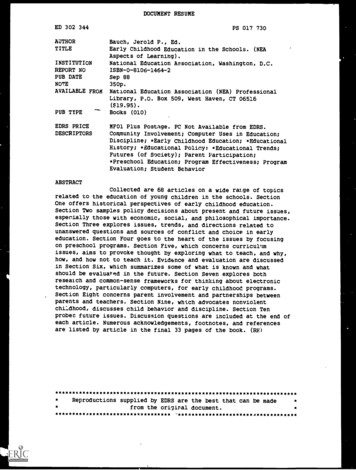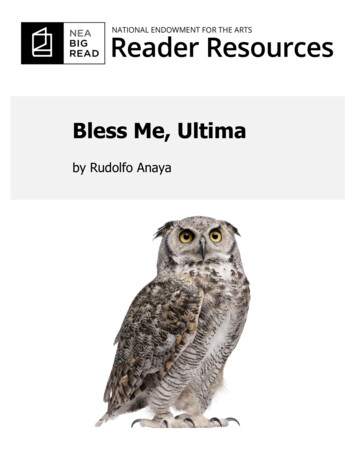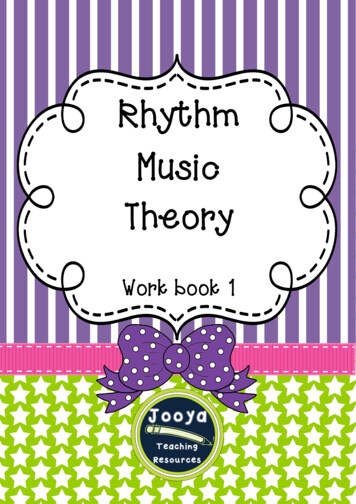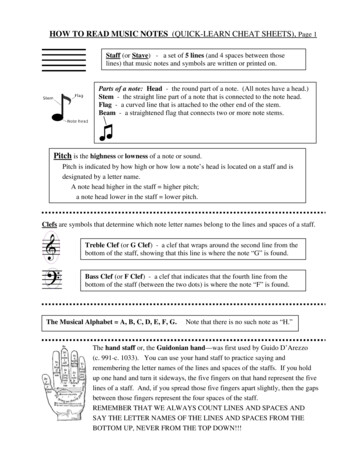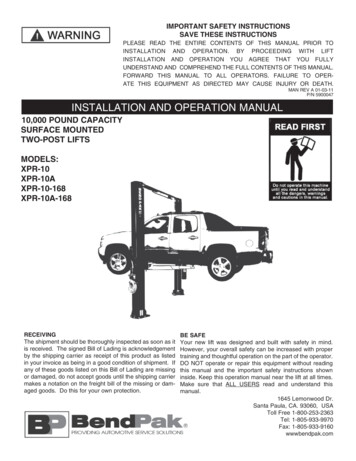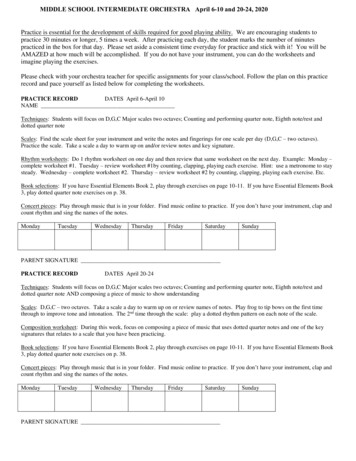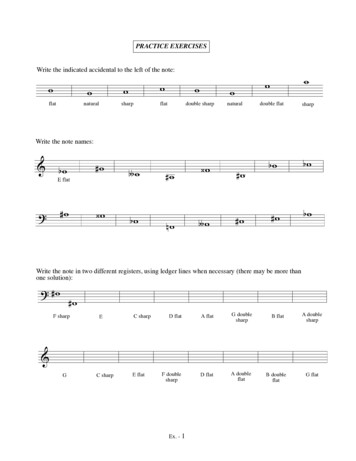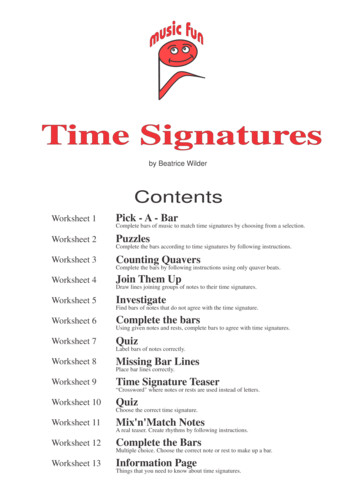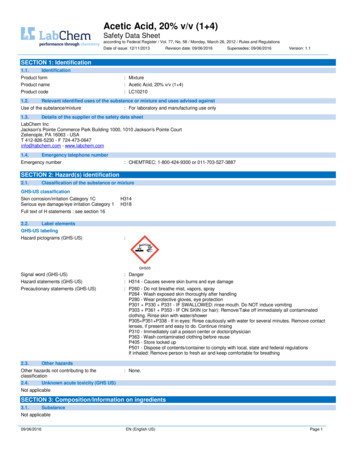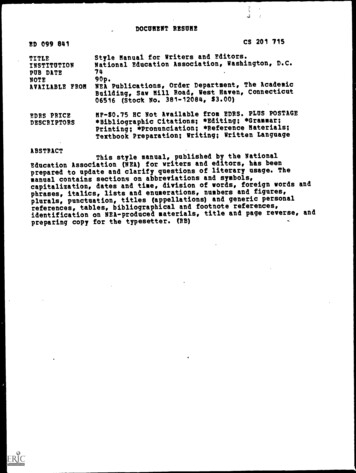
Transcription
DOCUMENT RESUMECS 201 715ED 099 841TITLEINSTITUTIONPUB DATENOTEAVAILABLE FROMStyle Manual for Writers and Editors.National Education Association, Washington, D.C.?DRS PRICEDESCRIPTORSMF- 0.75 AC Not Available from EDRS. PLUS POSTAGE*Bibliographic Citations; *Editing; *Grammar;Printing; *Pronunciation; *Reference Materials;Textbook Preparation; Writing; Written Language7490p.NEA Publications, Order Department, The AcademicBuilding, Saw Mill Road, Vest Haven, Connecticut06516 (Stock No. 381-12084, 3.00)ABSTRACTThis style manual, published by the NationalEducation Association (NBA) for writers and editors, has beenprepared to update and clarify questions of literary usage. Themanual contains sections on abbreviations and symbols,capitalization, dates and time, division of words, foreign words andphrases, italics, lists and enumerations, numbers and figures,plurals, punctuation, titles (appellations) and generic personalreferences, tables, bibliographical and footnote references,identification on NEA-produced materials, title and page reverse, andpreparing copy for the typesetter. (BB)
U S DEPARTMENT OF HEALTH.EDUCATION WELFARENATIONAL INSTITUTE OFEDUCATIONTHIS DOCUMENT HAS BEEN RE pkoDuCED EXACTLY AS RECEIVED ;ROMTHE PERSON OR ORGANIZATION ORIGINAT.NG it POINTS 0; VIEW' OR OPINIONSSTATED DO NOT NECESSARILY REPRESENT OF FICIAL NATIONAL INSTITUTE OFEDUCATION POS. TioN OR POLICYSTYLEmANuALNEA Style Manual for Writers and EditorsA NationalEducation AssociationPublication.41wCO1974 Edition,12)LUNational Education AssociationWashington, D.C. 20036
A".)AAAStyle Manual for Writers and EditorsA NationalEducation AssociationPublication1 17-1rimowtNational [(int:MIMI Ay;ourationWashinglor,, D C 20036
PI ' S.,,,I.r4PROP( CI THISBY MICROpW.AiFICHE ONLY .'. Hf f N ,.wANyt P BYNational Education Assnof the United Statesu4a1ANO OWC,Asoiat,ONS OPERATAGREEMI NTS MTH THE NA0 EDUCATION.NS,.{,/ THEW WEPWODUcTION OUTSIDETHE ER.0 SvStEM REQUIRES PERMISCU THE COPvw,c.,4T 0004ERICopyriv,ht 1962,National1966, 1974Education Associationof the United StatesAll Rights Reserved.Further reproduction in whole or part by permission only.NEA Stock No. 381-12084Library of Congress Cataloging in Publication DataNational Education Association of the United States.NEA style manual for writers and editors.1. Authorship I Iandbooks, manuals, etc. I. Title.l'N147.N26 1974.8080274-6142AIR
FOREWORDThis edition of the St vic Mantad has been prepared to updateand clarify question:; of literary usage in general and of NEA stylein particular so far as Association policies and educational particularitis dictate special attention. Association leathers and staff areurged to consult this book regularly and to direct their questionsand suggestions to NEA Publishing, Room 609, 1201 SixteenthStreet, N.W., Washington, D.C. 20036.The rules set down here cannot be exhaustive. For questionsnot covered here, consult an reputable authority. Both the Gm,-ernment Printing Office Style Manual and the Universit; ofChicago's Manual of Styli. are comprehensive in terms of grammar,punctuation, and the mechanics of writing and expression. WilsonFollett's .11odcrn American Usage is excellent for subtleties ofmeaning, and .Strunk and White's Elements of Style is withoutrival both for its conciseness and its views on rhetoric. The latesteditions of Webster's .Vele International Dictionary (1961) andWebster's Yew Collegiate Dictionary (1973) are recommended.
CONTENTSAbbre%ta:tons and Symbols72. Capitalization3.14Dates and Time224. Division of Words5.24Foreign Words and Phrases256. Italics.27Lists and Enumerations308. Numbers and Figures9.Plurals33.3610.Punctuation3911.Titles (Appellations). Generic Personal References5812.Tables6113.Bibliographical and Footnote References6414.Identification on NEI-Produced Materials7815. Title Page and Reverse16.80Preparing Copy for the "Typesetter81INDEX82
.Ibbreriations and SymbsI. AI313REVIATIONS AND SY11101.ti1.1. General Rules1.1.1. Peri( gls Q,itrall sh,tilti be used after abbrtAiations soul certain contractions of %von's and after a single letter or double lettersrepresenting vortts (see1. for abbreiations of states :nut 1.5.for m.11111(:I of s who's):.01,1)1.bat hclor of .titsabbil vt.ttiott,u t t.1, countin the year of our Lord IChristian eralbefore noonappro.apprositnatelassn.associationasst .assot late.tsst.assistant11.(:.bachelor of artsFurore Christboltilatht(:.11 Vcf.chap.o.d., ol.,t otlItIllItlit'trieVisiOn. Cable I !leisiotttinware, seet haptert ash on deliverycolumn. t oluninstontinurtlout.1).1).doctor of divinity1).1).S.1).S. I.dot for of dental surgerydaylight savings tittleI). I.it.dot for of liteaturtolupt.departmentdi\ Ishii'this.ethic .I.S. I.et al.et seq.rhosf. ft.fig.( ;NI'ibid.edit ationfor ,."oliphe lalays followed by a comma'Listen' standard timeand othersantl the followingand so forthand following page. and following pagesfiguregross national produt tin the sante place7
.1bbrevintios and SrmluslAintelligent c quotienti.e.,IfLLB.1.1.1).loc. cit.m.NIA.M.S.n., nu.no., nos.op. cit.P. pp.par.Ph.D."I owe you.that is 'always followed by a comma'dot tot of lawslightfacebachelor of lawsdoctor of lawsin the place citednoonmaster of artsdoctor of medicinemaster of sciencenote, notesnumber, numbersin the work citedpage. pagesparagraphsicdoctor of ewrong fontpl.p.m.pro temw (black and white) used inreferences to films and filmstrips should be set with space andwithout periods. Neither period nor space should be used withmm, the abbreviation of Ilintelt7. in referring to films; withrpm. the abbreviation of revolutions per minute, in referring torecordings: or %vith ips, the abbreviation of inches per second. inreferring to taped recordings:EXCEPTION: The abbreviation b16inm45rpm71,Aps1.1.2. Abbreviations composed of initials with periods should beset without space as should abbreviations of academic degrees:U.S.S.R.Ph.D.8
Abbreviations and SymbolsEXCEPTION: Initials used for a person's given name should beset with space:1. F. KennedyNOTE: Any initial preceding a surname should be followed by aperiod, even if it is not the abbreviation of a given name:Harry S. Truman1.1.3. Abbreviations in corporate and other formal names shouldfollow the form used on the letterhead or on official publica-tions: i.e., an ampersand should he used if it appears on theletterhead:Harper & RowNOTE: When it is not possible to obtain a company letterheadto determine the exact form of an organizational or corporatename, spell out all words about which abbreviation is uncertain.NOTE: When 11w is part of the official title of a university orassociation, it is permissible to lower case the article in lists forconsistency.lie is a member of The American Legion.AEW sponsors include the National Education Association, theAmerican Legion, and the U.S. Office of Education.1.2. Terms for Political Divisions, Geographical Terms1.2.1. The names of foreign countries (except the U.S.S.R.)should not be abbreviated.1.2.2. United States should not be abbreviated when used as anoun but should be abbreviated to U.S. when used as ar adjective:U.S. governmentU.S. foreign policy9
.Sviir/mAEXC1.111.1()N: %%lien used inforeign countr%111.11is spelledit.nameState.% should be!pelted ow (ln, %vbeli used .1% an aditi%e:United statis Itiiti.lt t.tlksrent Ii. German. and United states 1:mernments1.2.3. %%ien the name ot a state foil( Avs the name Of a city orany political c1i isionother geographit .1! term. it may beabbreviated in lists. statistical mat ter. Or bibliographic citations:John./ ones, president. New York. N. .Mary Jones. to retary. Helena. Mont.lb:it:Jones li%-s in Montana.)1.2.1.a. 'these Rvo-let ter abbreviations were established by theScr% ice tO facilitate the handling of mail and shouldbe used on all c orrspiiiidence:15.ti.KMontanaNI aARNIICanal ZoneC1New HampshireNew ,JersyNew Mexico(:olorado(;onset tictitCONiDelawareDENew YorkNorth Carolina:s.orth DakotaDistrit t tot' ( IntsttsMichiganNWNIAN'irgittiaVirgin iMNWest RPennsylvaniaPAPuerto KiloPRRhode IslandRISouth CarolinaSouth DakotaSt:l'ettnessetSI)TNEexasTxU.I.WA
.ibbreviations atul Symbols.xcept lot those states that are not commonly abbreviated (which appeal in pantheses), the states of the UnitedStates and the District of Columbia should be abbreviated asfollows when it is appropriate to do so in lists, references, andtext (see 7.3.2. for alphabetization of abbreviations and 7.3.3.for the position of District o/ a.Del.Nit!.Ha.Nlit h.Nlittn.Nliss.Miss.N.II.N.J.N. aho).(Nlaine)Nlass.'N. Dak.Nebr.P.R.R.I.S.C.S. Dirk.Fenn.tex.(nail)Va.*Vt.Wash.Wis.W. Va.WY0-*Kentur kv, Massa, husetts, Pennsylvania, and Virginia are officially styledommonwealths.1.3. NI.A AbbreviationsFiilloing arc lists of abbreviations of (a) departments, (b) national affiliates, and (c) associated organizations. These abbreviations should be used to avoid repeating long names after theyhave first been mentioned (see 1.5.2.).(a)ADTSEADSNREAAmerican Driver and Traffic Safely Education Asso iationDepartment of School NursesRtnal Education AssociationThe Department of Foreign Languages (DH.) and the Department ofVocational Education IDVE) are no longer active.(1)AAIIVERAvurAmerican Association for Health, Physical Education,and RecreationAssociation for Educational Communications andTechnologyA1AAAmerican Industrial Arts AssociationASCUAssociation for Supervision and Curriculum DevelopmentAssociation of Teacher EducatorsA IT.EK NEAmerican Association of EletnentaryKindergartenNursery Edut ators11
.ibbreviations and SymbolsI bone Economics Education AssociationJournalism Education AssociationME \CMusic Educators National ConferenceNALANational Art Education AssociationNALSNational Association of Educational SecretariesNAK:AL National Association for Public Continuing and Adult[ILEAJNASCNCSSN RA(c)AASI.AIDSC ECN BEANSPRANitSt:AEducationNational Association of School CounselorsNational Council for the Social StudiesNational Council of Teachers of MathematicsNational Retired Teachers AssociationAmerican Association of School LibrariansAssociation for Educational Data SystemsCouncil for Exceptional ChildrenNational Business Education AssociationNational School Public Relations AssociationNational Science Tea, hers AssociationNational Training LaboratoriesSpeech Communication Association1.4. References. In parenth, flea references in text and also infootnotcs, bibliographies, tables, and similar matter, certainwords tic:ignaling parts of a publication should be abbreviatedwhen accompanied by roman numerals, figures, or letters (see2.3.2. for capitalization and 8.2. for use of numerals):Jones argues (Vol. II, Chap. 6, pp. 67.68) that . .col., cols. (column. s)No. Nos. (Number, s)Fig., Figs. (Figure. s)p., PP. (page. s)I., 11. (tine, s)Pt., Ms. (Plate. s)n., nn. (note, s)Vol. Vols. (Volume. s)EXCEPTIONS:Act IV, scene 2, line 15Appendix IVparagraph 6Part IVTable 21.5. Symbols1.5.1. Neither periods nor space should be used with initialsthat function as shortened names of government agencies andother organized bodies (see 1.1. for initials with periods):I IEWVISTANLRBAIDGPO12NEACAREIrrANI ITOVA
Abbreviations. and SymbolsCommonly used symbols (IQ, CAIN, IOU, SOS) should be setwithout periods and without space; also the symbols for radioand TV stations (WGNIS, WNS-TV) and for standardized testsMAIM, which should be set in italics (see 6.6.1.).1.5.2. An unfamiliar symbol should not be used unless the fullname or title for which it stands appears previously in the text:The National School Boards Association has been askedto sponsor the meeting, which will be attended by representatives of the NSBA as well as by representatives ofthe National Congress of Parents and Teachers and theNational Education Association.NOTE: When such a symbol is to be used at a considerable distance from the full name of the agency or organizationor whenit may seem necessary for clarity for some other reasonthesymbol should be noted in parentheses immediately after thefirst mention of the title:The National School Boards Association (NSBA) hasbeen asked to sponsor the meeting. Discussion of thefollowing topics is planned. .13
Capitalization2. CAPITALIZATION (see also 1 1.3. for appellat ions)2.1. To Indicate Beginnings2.1.1. V.tentIpreceded by a (urinal introductory element followed by a colon, the first word of a complete sentence should beapifi.lized (see 10.4.3. for use of the colon):She offered several reasons for choosing Lake Ashton:(a) It would benefit the children, because they couldlearn to swim. (b) Its nearness to Boston would enable[tarry to stay late on Sunday evenings. (c) Many of herfriends were going there too.EXCEPTION: The first word alter a colon should not be capitalized when it introduces an element that is merely a restate-ment or amplification of the first element (see 10.4.1. and10.4.2. for this use of the colon).2.1.2. The first word of each item in a list or an enumeration inblock form should be capitalized (see 7. for form of lists):Ile had three reasons for taking a vacation:1. Fine weather2. Ills longing for the sea3. The failure of his business.2.1.3. The first word of (a) a formally introduced quotation,(b) a cited speech in direct discourse, and (c) a direct thoughtor question should always begin with a capital (see 10.4.3. foruse of colon and 10.9. I. for use of quotation marks):(a) The Aeneid begins: "Arma virumque cano. . . ."(b) Ile replied. "There will never he another holiday like this."Ile asked. "Who is she?"(c) I thought to myself. There will never be another holidaylike this.We may ask. How can this be done?There are two questions: What should be done? and Whowill do it?NOTE: When a quotation is introduced by that, neither colonnor capital should be used, even though the first word beginsa sentence in the original:14
CapitalizationThe New York limes editorial ends with the ironic statement-that "everything is line in Suez."2.1.4. In resolutions, the first word following Whereas or Re .solved should he capitalized:Whereas. It is the sense of this meeting. .Resoked, That all citizens under twenty-one.2.2. Titles and Headings2.2.1. In publication titles and section headings set with initialcapital letters, all words except articles, coordinate conjunctions,and prepositions of less than five letters should he capitalized,unless design considerations call for a different system:.1dmInistration: l'rocedures and School l'ractices for theAcademically Talented StudentDemocracy Through EducationEXCEPTION: The first and last words of a title or headingshould always be capitalized, even though they would not becapitalized in another position:The Votes Are InExc.:Emus: The first word of a subtitle following a colonshould he capitalized:Curriculum Development:HistoryEXCEPTION: All words that are inseparable parts of verbsshould be capitalized:They Woke Up the Citizens2.2.2. The to preceding the verb of an infinitive should be capitalized in a title or heading:flow To Listen to Your Child2.2.3. In hyphenated compounds, all elements except articles,coordinate conjunctions, and prepositions of less than five letters should be capitalized in titles and headings:15
CapitalizationBoy Secs WilliftheWispI ligh-and-Mighty Politician Takes Tumble2.2.4. Equal elements in personal titles should be capitalizedwhen capitalization is appropriate (see 12.3.):Secretary of State Rogers2.3. References2.3.1. In a citation of any published work, the title should becapitalized according to the rules given at 2.2., even though theresulting capitalization may not conform to the capitalizationof the title in the original publication.NOTE: When the title of a commercial publication is printedentirely in capital letters in the original publication, only theinitial letters should be capitalized in a reference:FortuneTimeEXCEPTION: ,VE.1 NOW2.3.2. An imperative verb at the beginning of a reference inparentheses within a sentence should not be capitalized (see6.3.1. for italicization):In our earlier discussion (see p. 472), we dealt. . .2.3.3. Lower case foreword, preface, introduction, contents, appendix, glossary, bibliography, and index in passing references toa publication, but capitalize the same words when they are usedin a publication to refer to another part of that same publication:lie spent a great deal of time writing a lengthy foreword.This subject is treated in greater detail in the Appendix.2.4. Proper Nouns and Adjectives. Generally. proper nouns andwords used as proper nouns, such as (a) epithets used as substitutes for proper names, (b) common nouns used alone as wellknown forms of proper names, (c) personifications, and (d) nounsof address should be capitalized:16
Capitalization(a) I loly We itthe Pretender(b) the District I District of Columbia)the Cha(English Channel)(c) The Chair recognized the gentleman.(d) Alr. Chairman, Ladies, and Gentlemen:Dear Sir:NOTE: When two proper nouns that have the same final element are linked by a conjunction, the pluralized final elementshould be capitalized.Harvard and Tu lane UniversitiesCardozo and Walter Johnson high Schools2.4.1. Accepted geographical names, including popular appellations for regions and localities, should be capitalized:the MidwestMalay PeninsulaLevantCorn BeltEternal CityDeep SouthWest CoastWestern HemispherePlace references that are merely descriptive should notbe capitalized:Potomac watershedMaine coast2.4.2. The names of the points of the compass, and adjectivesderived from them, should be capitalized (a) when they arc partof a name established by usage as a designation of a specificregion and (b) when they themselves are designations of specificregions or people from those regions:While in the Far East, and particularly while living withfriends in Southeast Asia, he lost many of his Westernmannerisms.The vote of the Midwest was not surprising, but that ofthe Deep South was.Charles was curious about the Southerners who had justcome north.NOTE: The names of the points of the compass should not becapitalized when they simply ind:cate direction:There were more jobs farther scuth, but she liked theweather in the northern section c t the state,17
Capita lization2.4.3. Names of political divisions should be capitalized whenthey follow a specific name and are used as proper names:French Republic.Persian EmpireSixth Congressional DistrictBaltimore CityNew York StateNew York CityNOTE: When the names of political divisions are used descriptively with of preceding a specific name, they should not be capitalized:empire of the Persiansstate of New York2.4.4. Names and fanciful epithets for historical epochs shouldbe capitalized:Middle AgesRoaring TwentiesRestorationGreat DepressionNOTE: Centuries ,end decades should not be capitalized;twentieth centurythe forties2.4.5. All names for the Bible and other sacred books, and fordivisions of the Bible and other sacred books, should be capitalized and set in roman type without quotation marks:holy ScripturesVedasKing James VersionVulgateKoranBook of JobParable of the SowerNew TestamentNOTE: Adjectives derived from such nouns should not be capitalized:scripturalkoranicvedicbiblical2.4.6. The word church should be capitalized when it is a partof the name of (a) a religious denomination, (b) a religious organization of the whole world or of a particular country, evenwhen it stands alone, and (c) a particular edifice:(a) the Protestant Episcopal Church(b) the Church of RomeThe struggle between the Church and the State was settledipso Act() by Henry VIII.(c) the First Baptist Church on Main Street18
CapitalizationNOTE: Except as in (1) above, the word church should be lowercased when it is not a part of a proper name:There is a Baptist church in this town.The separation of church and state is an American tradition.2.4.7. (Onion and Republic (hut not maim) should be capitalizedwhen referring to the United States; Administration should becapitalized when referring to the executive branch of the U.S.government; Senate, House, Senator, Representative, Congressman, and Congresswoman should be capitalized when referringto the U.S. Congress and its members, even when these wordsstand alone; Supreme Court and High Court should be capitalized; and all appellations of the president of the United Statesshould be capitalized, as, for example, Chief Executive andCommander ih Chief.The United States is a republic.But:The politician claimed that the Republic was in jeopardy.NOTE: The words federal and state should not be capitalizedexcept as part of a title:federal Constitutionstate department of education(but: Federal Communications CommissionNew York State Wm ation Department)2.4.8. The names of national and international bodies shouldbe capitalized:Eightieth CongressCabinetSecurity CouncilWorld Bank2.4.9. The distinguishing word in a reference to a political partyshould be capitalizd, but these same words should not be capitalized when used to describe a political philosophy:If he is a member of the Communist party, he is a Communist.The Democratic party won the !louse.Although the National party is the least republican of the parties that have won votes, it is opposed to communism.2,.10. The names of national and international governmentaldocuments should be capitalized:19
CapitalizationNational Labor Relations ActEqual Rights AmendmentConstitution of the United StatesCharter of the United Nations2.4.11. Whenabbreviated form of the name of an organization, committee, or similar group is used after the full name hasonce been spelled out, the shortened form should be considereda substitute for the full name and should be capitalized:After the Department of School Nurses was organized, theDepartment. .NOTE: In NEA publications, the word .Issociatiun should becapitalized when used to refer to the National Education Association, even when it stands alone.NOTE: Do not capitalize united teaching profession when referring to the National Education Association. This descriptivephrase is not an alternate official title and should nut be used inthat way.2.4.12. Formal names of groups of people and races should becapitalized:ChicanosSaxonsOrientalsFirst AmericansNegroesCaucasiansNOTE: Group designations based on physical characteristicsshould be lower cased:blackbrownwhiteEXCEPTION: Black, when synonymous with Afro-American,should be capitalized.EXCEPTION: Black and Blacks should be capitalized in a seriesof capitalized racial names:Chinese, Japanese, and Black parents sent a delegation.2.4.13. The terms NEA headquarters and NEA Centerwhenreferring to the building at 1201 Sixteenth St., N.V., Washington, D.C. are considered proper names and should be capitalized. If NEA is the implied antecedent, headquarters and(]enter should be capitalized even when not preceded by NM.20
Capitalization2.5 Nio.cellaneous2.5.1. When spelled out, academic degrees should not be capitalized (see 1.1.1. for abbreviations):master of artsbachelor of laws2.5.2. The names of seasons of the year should not be capitalized.2.5.3. The abbreviations B.C., .1.D., E.S.T., and D.S.T. shouldbe capitalized (see 3.2.2. for position and 3.3.3. for repetitionof century). Do not capitalize a.m., p.m., or m.21
Dates am/ hm.3. IMTES AND TIME3.1. General Rules (see 8.1.1. for treatment of decades)3.1.1. The ordinal forms IU!. rd. 1/i. and st should he omitted indates expressed by figures. However, after the nuth has beenestablished, subsequent references to dates in that month shouldbe in written ordinal form:She will arrive here on Nlay 1 :3 and will leave for Mexico on thetwentieth.January 2October 13.1.2. No comma should be used between the month and the year in a date, unless the number of the da!, is used:December 1972December 10. 19723.1.3. In a date, the year should be set off by commas if .eyear follows the month and the day in text:On March :3. 1973. he will turn 65.3.2. A.D. and B.C.3.2.1. A.D. and B.C. should be set in capitals with periods andwithout space.3.2.2. A.D. precedes the year; B.C. follows the year (see 2.5.5.for capitalization and 3.3.3. for repetition of hundreds):A.D. 1973500 B,G,3.3. Spans of Time3.3.1. A dash should be used to mark the omission of the wordlo when indicating a span of time:Nlay June 1936January 1. 1972 January 1. 1973NOTE: See 16.2.2. for the typing of a dash.22
Dates and .TimeNOTE: When the word from is used in such an expression, theword to must be used instead of a dash:The fiscal year runs from .Jutie I. l971. to .1 tine 1, 1972.3.3.2. To indicate a span of years, tvo figures should be usedfor the terminal years:19tY1911-18EXCEPTION: When the first year ends-in two zeroes, the entire figure should be written for the terminal year:1900-1973EXCEPTION: hiur figures are sometimes used for the trminaldate on covers, title pages. and in other instances when design isa primary consideration.3.3.3. In citations of dates before Christ, the hundreds shouldalways be repeated:387-325 B.C.A.D. 170-753.4. Clock Time3.4.1. Spell out times of day in narrative and in text when theexact minute is nut emphasized.We eat at half-past seven.Be there about four o'clock.NOTE: The word 0 Work is not used with abbreviations ofmeridian or with figures.The baby was born at 10:22.llis father had to get up at the ungodly hour of 3 a.m.NOTE: Figures should always be used with abbreviations ofmeridian.itt a.m.12 m. (noon)2:30 p.m.12 p.m. (midnight)23
Division of Words4. DIVISION OF WORDS4.1. General Rules4.1.1. The most recent editi9n of Webster 's New CollegiateDictionary (which is based on the 1961 unabridged Webster'sNew International Dictionary) should be the authority on worddivision. The New International should be consulted for wordsnot listed in the Collegiate.4.1.2. A word may be divided only at the end of a syllable, asindicated in the dictionary:hegemo-nyMes-mer-iceTherefore, words pronounced as one syllable should not bedivided:honedLoafedpickedtrilledEXCEPTIONS: Words of two syllables of which one is (a) asingle vowel or (b) its equivalent should not be divided:(a) awayunite(b) authoreitherNOTE: Break hyphenated compound words at the hyphen andnonhyphenated compound words at the original natural break.When possible, divide words with prefixes after the prefix;divide words with suffixes before the suffix.intro-ducebusiness-like24
Foreign Words and Phrases5. FOREIGN WORDS AND PHRASES (see 9.1.3. for pluralization)5.1. General Rule. Foreign words and phrases appearing in English text should he italicized if they are likely to be unfamiliarto the reader. When in doubt do not use italics.5.1.1. The following words have been incorporated into theEnglish language and should not be italicized:a prioriad infinitumad nauseumalma materamicus curiaeante heliumaproposattachebona fidecarte ,blanch eclichecommuniquecon, contradebrisdenouementdilettanteen routeentreeentrepreneuret ceteraex officioexposegenrehabeas corpuslaissez fairemea culpamilieumoresnaivepar excellenceper annumper capitaper diemper sepro ratapro temraison dltreregime,resumestatus quosubpoenatete-ateteversusvice versavis-avis5.1.2. Roman type should be used for (a) foreign titles preceding proper names; (b) names of foreign streets, hotels, and thelike; (c) names of foreign institutions; and (d) names of foreigncoins:(a)tire Marquettelierr DingelDon Juan(c)Keichsta,gBibliotheque NationaleAcademia EspanolaChamps ElystlesAlbergo NazionaleLouvrelirafrancruble25
Foreign Words and Phrases5.2. References. Latin words, phrases, and abbreviations used inliterary and legal references should usually be italicized:circa or cu. "about"17. (170ruit). "he lived"ibid. (ibidem). "the same" referenceidem. "the same" personloc. cit. (loco (*auto). "in the place cited"op. cit. (open. Mato). "in the work cited"passim. "here and there"EXCEPTIONS:e.g. (exentpli gratin), "for example"etc. (et cetera). "and others" or "and so forth"i.e. (id est). "that is"v. or vs. (versus). "against"NOTE: See 10.5.10. for comma after e.g. and i.e.5.3. Scientific Names. The scientific names of genera, subgenera,species, and subspecies should be italicized. The names of groupsabove genera (phyla, classes, orders, etc.) should be in roman.the genera Quercusthe family Leguminosac26
Italics6. ITALICS6.1. Differentiation. Words used with a special meaning shouldbe italicized the first time they are used; letters used as lettersand words used as words should always be italicized (see 6.4. and9.1.2. for pluralization):The wrath of God was discovered to him, in the Miltonian sense.It was discovered as the nemesis.It is hoped that a's and b 's will be used as little as possible in thisnontechnical manuscript.It is often interesting to study a child's use of the word becausein his compositions.6.2. Ent/Oasis. Italics may be used to emphasize particular wordsor phrases:The basis of his life was hoping, not planning.CAUTION: If such use of italics is overdone, the desired effectwill be lost.6.3. Directives (see also 5.2. for use of Latin words)6.3.1. The words see and see also should be italicized in indexes,but they should not be italicized in text matter, whether enclosf:d in parentheses or not, or in footnotes (see 2.3.3. for capitalization).6.3.2. The following phrases should be italicized:ContinuedContinued fromTo be conc
mANuAL. STATED DO NOT NECESSARILY REPRE SENT OF FICIAL NATIONAL. INSTITUTE OF. EDUCATION POS. TioN OR POLICY. NEA Style Manual for Writers and Editors. A National Education Association.41w. Publication. CO. 1974 Edition,12) L
